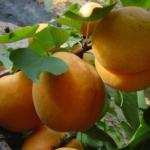University of California
The California Backyard Orchard
Apricot (Prunus armeniaca L.)
Apricots bloom in February and early March, usually during a cold rain storm; thus, consistent crops are unlikely in North Coast counties.
Apricots perform best in climates with dry spring weather. They are susceptible to late spring frosts. Bacterial canker is a common disease of young trees in California.
Plant trees at about a 10 to 20 ft. spacing. Apricots are mostly self-fruitful and ripen in late June to July (100–120 days from full bloom).
Calendar of Backyard Gardening Operations for Apricots
Winter Dormant Season
- Spray trees with dormant oil to control San Jose scale, aphid eggs, mite eggs, and peach twig borer.
- Do not use sulfur on apricots, ever.
Spring Bloom Season
- Spray to control brown rot and shot hole fungus as blooms start to open. Sprays may be required at 10–14 day intervals if weather is rainy.
- Drip irrigate daily or sprinkler irrigate every 2–3 weeks.
- Fertilize before 1st irrigation with 1–2 lb. of urea. Water in.
- Thin fruits to about 4–6" apart when 1/2–5/8" diameter.
- Paint trunks with 50/50 mix of white interior latex paint and water to prevent sunburn and borer infestation.
Summer Growing Season
- Continue same irrigation schedule as in spring.
- Fertilize young trees monthly at ¼ spring rates to encourage vigorous growth.
Fall Harvest Season
- Prune trees before onset of winter rains to prevent Eutypa fungus infection of pruning wounds.
- Remove about 20% last year’s growth to let light into tree.
- Remove old, broken, diseased branches.
- Spray trees during or after leaf fall but before onset of winter rains to control shot hole fungus.
- Do not use sulfur on apricots, use fixed copper.
Resources
- Apricot Links, UC Fruit and Nut RIC
- [PDF] Apricot Varieties for Planting in the Home Garden, Paul Vossen and Deborah Silver, Sonoma and Marin Co. UCCE
- How to Manage Pests in Gardens and Landscapes - Fruits and Nuts, UC IPM
